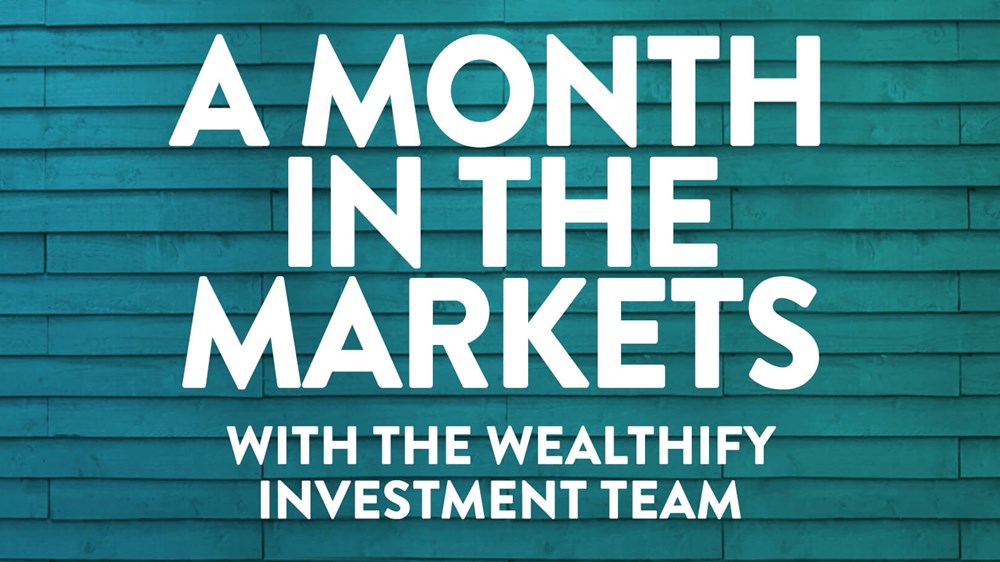Please note: this blog was published in March 2023 and its content is based on what was correct at the time of writing. As a result, some of the facts and opinions may no longer be current or relevant.
March 2023 saw a rollercoaster of emotions in the markets, and you could say that it was a month of two halves.
So, what happened exactly?
It started with a banking turmoil, which was due to the failures of Silicon Valley Bank and Signature Bank, and the rescue of Credit Suisse by its biggest rival, UBS. This was a shotgun wedding of sorts, orchestrated by the Swiss authorities.
These events sparked concerns across the banking system and led to a wave of fear in the markets. Policymakers introduced extraordinary measures to secure bank deposits and prevent further bank runs (where customers flock to withdraw money from their bank due to a lack of confidence).
But when the stability of the financial system is at risk, the 2008 crisis often comes to mind for many investors.
Consequently, the initial market narrative was one of central banks avoiding a financial crisis at all costs, which implied putting inflation concerns on the back burner. As a result, this led to a dramatic shift in market interest rate expectations, and markets now anticipate rate cuts to happen later in the year.
In the second half of the month, however, fears in the banking system subsided, and the narrative shifted to "bad economic news is good news for risk assets". Lower interest rate expectations provided a boost to both bonds and shares, with most regions ending the month positive.
But economic indicators continue to present mixed signals. Although manufacturing activity has been weak, particularly in developed markets, service sector activity accelerated across most major economies in March. US inflation (excluding food and energy) remained elevated at 5.5%, mainly due to strong consumer spending and rising wages, which continue to put pressure on the cost of services.
However, financial conditions are expected to become more restrictive after the recent banking scare, and there are some early signs that the hot labour market may be starting to cool down. Although this may have a negative impact on salaries and company earnings, it would also help reduce inflation.
Deteriorating financial conditions can have a significant impact on inflation and unemployment, and the recent developments in the banking sector have caused some depositor fright and subsequent flight. And money market funds have seen the biggest month of inflows since the Covid-19 crisis. Put simply, this means that many people decided to move their savings away from bank deposits into funds which invest in short-term, high-quality debt securities.
After a long period of interest rates that were at levels near zero, banks may now have no choice but to improve their rates on customer deposits to retain their clients. This is likely to squeeze banks’ profits and in turn increase the rate on loans, which could slow economic growth.
What is the data telling us?
The US jobs report continued to indicate strong gains, with 311,000 jobs added in February. However, the strength is not broad-based, and wage growth fell below expectations, which should help with inflation. In addition, the unemployment rate increased from 3.4% to 3.6% partly due to an increase in labour force participation.
The combination of banking turmoil and mixed economic data forced the Federal Reserve to take a more measured approach with a rate increase of 25bps to a range of 4.75%-5%.
In Europe, inflation (excluding food and energy) continued to climb to 5.7%, which suggests that the European Central Bank (ECB) may have to tighten interest rates further. Meanwhile, inflation also increased in the UK and was hotter-than-expected in February, driven by a 12.1% annual increase in the restaurants and hotels category.
During the month, the ECB raised interest rates as promised from 2.5% to 3% (despite market unrest), whereas the Bank of England announced a quarter-point rate hike, from 4% to 4.25%.
Despite the recent uptick in prices, the UK is starting to see signs of slower growth in salaries and a softer labour market. The housing market is also deteriorating as higher interest rates have made mortgages more expensive. Relative to other countries, the UK stock market has more exposure to banks, and therefore, this month’s performance has been weaker.
We welcome the recent positive market performance but remain cautious on equities for now, as we believe equities have gotten ahead of themselves. Current expectations of rate cuts in the second half of 2023 are overly optimistic in our view, as we continue to think that it is too early to declare victory on inflation.
Furthermore, we are aware that past policy reversals haven't always resulted in lasting uptrends in the stock market. This has been demonstrated by the bear markets (periods where share prices are in a negative trend) that we experienced in 2000-2002 and 2007-2008. These took place despite aggressive rate cuts.
Markets
March was a month of ups and downs in the markets, as the early chaos eventually transitioned into a strong rebound. The change in interest rate expectations benefited both stocks and bonds, and it also resulted in a weaker US dollar.
Concerns over a banking crisis and a potential economic downturn had a negative impact on sectors that are most exposed to the ups and downs of the economy. Those regions with higher exposure to banks and property suffered more severe declines, whereas expectations of central bank rate cuts benefited growth-oriented sectors.
Despite the banking turmoil originating in the US, it turned out to be the best-performing region (+3.5%), driven by big tech companies. This was followed by Emerging Markets (+2.7%), which benefited from a weaker US dollar and an ongoing recovery in the Chinese economy. Conversely, the UK saw a decline (-3.1%) due to its more defensive bias and significant exposure to the financial sector. Europe and Japan ended the month broadly flat.
Currency
The USD weakened by 2.6% against sterling, this is despite its safe haven qualities, as expectations of the Fed cutting interest rates in H2 grew. As a large part of our US share allocation is hedged back into sterling, the weakness in the US dollar had a less detrimental impact on Plans’ overseas exposure.
Otherwise, sterling remained unchanged against both the Euro and the Japanese Yen in March.
Investment type performance breakdown
In our Original Plans, shares (+0.35%), infrastructure (+0.18%), and bonds (+1.77%) all ended the month in positive territory. However, property (-6.35%) faced the repercussions of the banking turmoil, as financial stability is crucial for the sector's well-being, given its dependence on access to capital for refinancing debt. The property sector can be volatile in periods of financial turbulence, and therefore we only have a small allocation.
Our Plans benefitted on a relative basis from a lower allocation to shares. Our allocation to bonds gained from lower interest rate expectations, whereas our US dollar hedge also added positively to performance.
Ethical shares (+0.50%) performed marginally better than Original due to their bias towards growth sectors. However, Ethical bonds (+1.57%) underperformed slightly relative to Original. Overall, Ethical and Original Plans performed similarly last month.
Summary with Plan details
Original and Ethical Plans delivered positive returns across all risk levels in March. As mentioned, investors found themselves in a ‘bad news is good news’ environment as the banking chaos overshadowed inflation worries and prompted investors to dismiss the possibility of additional rate increases.
Ultimately, this had a positive impact on both stocks and bonds. Although share markets held up despite the initial fears, bonds delivered a stronger performance driven by their safe haven qualities and a dramatic shift in interest rate expectations.
In March, Plans with a higher allocation to bonds performed better than those with a higher allocation to higher-risk assets. We expect further volatility as the market reacts and digests the flow of economic data, which itself has a high uncertainty attached to it. Therefore, we continue to position our Plans with caution.
Our Investment Team continues to actively monitor the financial markets and their impact on your Plan — and are always ready to act in your best interests to events as they unfold. We are continually evaluating new market information and key market drivers to help keep your Investment Plan on track.
It’s important to remember that it’s normal for markets to go up and down, with periods of volatility to be expected when you invest. As always, we continue to look for opportunities to position your investments, with the goal of protecting your money and achieving your long-term objectives.
Please remember the value of your investments can go down as well as up, and you could get back less than invested. Past performance is not a reliable indicator of future results.



